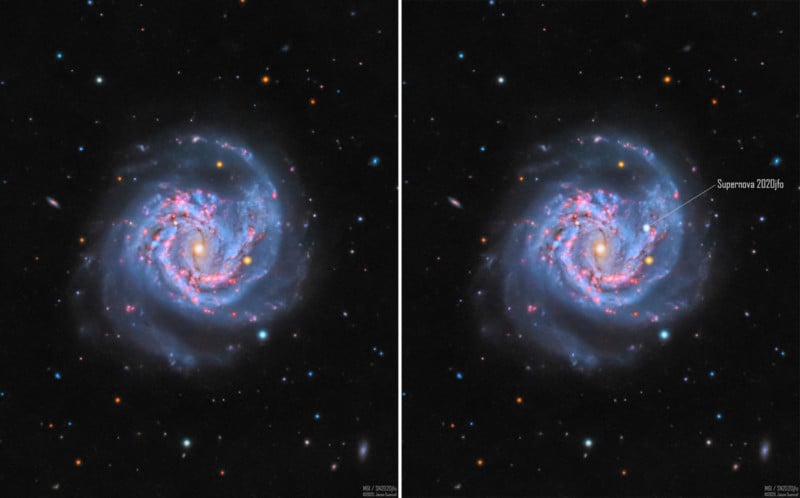Photographer Captures Star Exploding in Before-and-After Photos
![]()
Back in February, photographer Jason Guenzel began photographing a particular galaxy in the sky on moonless nights. Then in early May, he captured something unexpected and extremely rare: a star exploding, or the birth of a supernova.
“I am shooting under suburban light pollution, which is the dominant source of noise in each shot,” Guenzel tells PetaPixel. “The process involves taking many short sub-exposures and stacking them to increase the exposure time. This essentially averages them to produce a higher quality end result.”
To shoot the Messier 61 (M61) galaxy, Guenzel has been using a $1,350 Celestron EdgeHD 8” telescope, a $2,000 Orion Atlas Pro Mount, and a $1,280 ASI1600MM monochrome CMOS camera.
“I stacked 800 short sub-exposures (‘subs’) taken over many moonless nights spanning from February through May 2020,” Guenzel says. “The side effect of this process is that I have a historical record of the galaxy as it appeared over those months.
“With a fortunate stroke of luck, a supernova appeared in the arm of M61 in early May. I was able to process the galaxy data to reveal the appearance before and after this star exploded. The light from the explosion had been traveling across space for 50 million years before landing on my camera sensor.”

The photos above show true color tones and resulted from 27 hours of total exposure time, having been captured with a monochrome camera through luminance, red, green, and blue filters.
“Though it’s hard to quantify, catching a bright supernova in one of the brighter galaxies in the night sky is a rare accomplishment,” Guenzel says. “I feel fortunate to have been in looking in the right place at the right time. ”
Here’s a timelapse Guenzel made with a sequence of his photos before and after the explosion:
Eight supernovae have been observed so far in M61 starting with the first one recorded on May 9th, 1926. The latest one that Guenzel spotted is named SN2020jfo.
“This is a Type II event,” Guenzel says. “The massive star depleted its nuclear fuel. As it exhausted light elements like hydrogen and helium, it began fusing heavier and heavier elements, eventually reaching iron. At this point, it could no longer support itself with outward pressure against the tremendous gravity.
“This type of supernova starts with an implosion and an almost immediate reversal to a massive explosion which, as you can see here, can literally outshine an entire galaxy for many weeks. Through this process, it seeds the building blocks for a new generation.”
You can find more of Guenzel’s work and follow along with his journey on Facebook, Twitter, and Instagram.